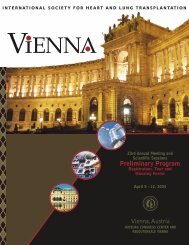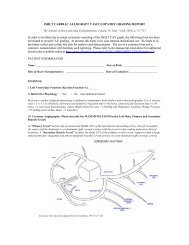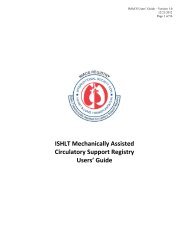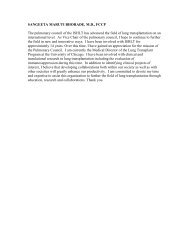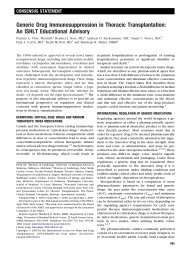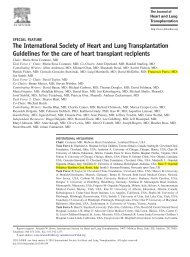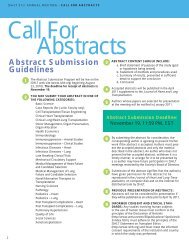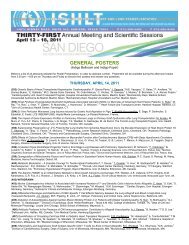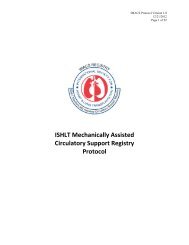Task Force 4: Inpatient Management of Patients with MCSD - The ...
Task Force 4: Inpatient Management of Patients with MCSD - The ...
Task Force 4: Inpatient Management of Patients with MCSD - The ...
You also want an ePaper? Increase the reach of your titles
YUMPU automatically turns print PDFs into web optimized ePapers that Google loves.
catheter care. 34 <strong>The</strong> same technique is used daily by nurses for median sternotomy,<br />
chest tubes, drivelines, and abdominal pocket wounds. Nurses apply hat, mask, sterile<br />
gloves and gown, and while the dressing change is in progress, noone is allowed to<br />
enter the room. <strong>The</strong> dressing change protocol includes 4 steps: 1) gauze soaked <strong>with</strong><br />
anti-septic solution is used to cleanse the exit site and surrounding skin; 2) <strong>The</strong> area is<br />
rinsed <strong>with</strong> gauze soaked <strong>with</strong> sterile water; 3) <strong>The</strong> area is dried <strong>with</strong> gauze; 4) 2 x 2<br />
gauze is applied and then covered by transparent occlusive dressing. 34 At some<br />
centers, antiseptics or antibiotics are applied around the driveline site such as povidoneiodine,<br />
silver sulfadiazine, and chlorhexidine to inhibit growth <strong>of</strong> colonizing bacteria. 8<br />
Treatment <strong>of</strong> Device-Related Infections. Most device-related infections occur in<br />
the later phase <strong>of</strong> <strong>MCSD</strong> therapy, and management <strong>of</strong> these is reviewed elsewhere in<br />
these guidelines. However, early occurrence is possible. <strong>The</strong> general measures outlined<br />
in this section, such as appropriate management <strong>of</strong> lines and tubes, careful stabilization<br />
<strong>of</strong> the driveline, and judicious care <strong>of</strong> the driveline exit site serve to reduce early risk <strong>of</strong><br />
infection.<br />
Recommendations for Infection Prevention Post MCS <strong>The</strong>rapy:<br />
Class I:<br />
1. <strong>The</strong> driveline should be stabilized immediately after the device is placed, and<br />
throughout the hospital stay.<br />
Level <strong>of</strong> Evidence: C.<br />
2. A dressing change protocol should be immediately initiated post operatively.<br />
Level <strong>of</strong> Evidence: C.<br />
3. Secondary antibiotic prophylaxis for prevention <strong>of</strong> endocarditis has not been studied<br />
in the MCS population, but it would be considered reasonable due to the risk <strong>of</strong><br />
bacteremia in this group.<br />
Level <strong>of</strong> Evidence: C.<br />
Nutrition<br />
<strong>The</strong> main goals <strong>of</strong> a post-operative nutritional plan are to promote surgical wound<br />
healing, optimize immune function, and improve the macro- and micronutrient substrate<br />
11





